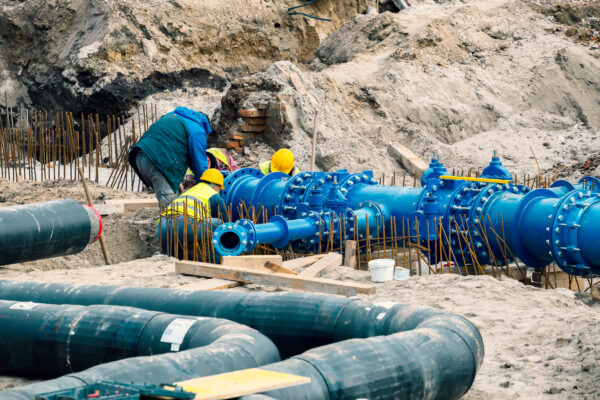Can you give us a quick overview of what your team focuses on when it comes to designing and managing utility systems like water, electricity, and fiber?

Our utility division is comprised of three specialized teams: Water Resources, Electric, and Fiber, each dedicated to delivering targeted solutions within their respective fields:
- Our Water Resources team tackles all aspects of water and wastewater infrastructure, managing hundreds of improvement projects daily. From water and sewer line replacements to pump stations, treatment facilities, and storage systems, we provide innovative solutions that support sustainable water management across the U.S. In addition, our team offers full design capabilities for natural gas projects, ensuring safe and efficient fuel distribution.
- Our Electric team focuses on power infrastructure, working on distribution and transmission system upgrades, power generation and integration, Arc Flash coordination studies, asset management, and utility coordination. Their expertise ensures grid reliability and efficiency for communities and industries.
- Our Fiber/Broadband team specializes in outside plant (OSP) design for fiber communication networks, bringing high-speed connectivity to homes, businesses, and multi-dwelling units. They also provide GIS asset management, utility make-ready work for joint use, and broadband expansion strategies, ensuring seamless network deployment and integration.
Our teams are involved in every stage of project development, from initial planning to final construction oversight. This includes master planning, preliminary engineering reports, water sampling and testing, hydraulic modeling, and concept design to establish a strong foundation for each project. As projects advance, we integrate survey data, CAD design, GIS mapping, and detailed plan and specification development to ensure accuracy and efficiency.
Beyond design, our teams provide permitting, bidding support, and comprehensive construction phase services. Our on-site inspectors act as the owner’s representative, ensuring that projects are built to the highest standards and comply with all regulatory requirements. Through this full-service approach, we help clients navigate complex infrastructure challenges and deliver reliable, long-term solutions.
While each team specializes in a specific area, collaboration is at the core of our utility division. Our teams frequently work together to tackle multidisciplinary utility projects, leveraging their collective expertise to deliver comprehensive solutions. For example, our GIS services play a vital role not only in utility infrastructure projects but also across the entire company, providing critical mapping and asset inventory for transportation, traffic engineering, and private development projects. This cross-functional approach enhances efficiency, improves project outcomes, and ensures seamless integration across all aspects of our work.
What Are the Biggest Utility Infrastructure Trends and Challenges Facing the Utility Sector Today?
I believe one of many challenges facing most utilities are workforce shortages and knowledge transfer. The industry is facing an aging workforce, with many skilled employees nearing retirement. U.S. employers will need to hire on average more than 240,000 people a month for the next five years just to replace jobs being left by those retiring from the workforce. Many of these jobs in the utility sector require highly trained and qualified staff to operate and maintain critical water, sewer, gas, and electric/broadband infrastructure. These jobs require hard work and sometimes long hours. Attracting, training, and retaining skilled workers to fill the gaps left from early baby boomers for these positions is challenging. With the departure of aging staff goes deep institutional knowledge of these utility systems which in some cases is lost forever. This is why it is critical over the next few years for utilities to make sure this knowledge is captured and transferred to new staff. The easiest way to do this is to build robust GIS Mapping as part of Asset Management planning that can be used by the next generation in the workforce and easily shared many years into the future.
Another major challenge facing utilities is aging infrastructure and capital investment needs. Many water, sewer, natural gas, and electric utilities rely on decades-old infrastructure that is in need of costly repairs or replacement. The average age of water and sewer pipes in the U.S. is 40 to 50 years old and are now reaching or exceeding their design lifespan. An estimated 240,000 water main breaks occur annually due to aging infrastructure. The EPA estimates that the U.S. needs $743 billion in water and wastewater infrastructure investment over the next 20 years to replace aging systems. Securing funding for capital improvements and maintenance is an ongoing challenge, particularly in rural and smaller utility systems where the customer base is limited as is the revenue generated to help pay for repair and replacement of aging infrastructure. Balancing rising operational costs with the need to keep rates affordable is a major concern.
On the electric side, grid modernization & reliability is a major challenge for many utilities, electric cooperatives and power providers. Much like water and sewer infrastructure, electric utility/providers need to invest in replacing outdated transmission and distribution lines, transformers, and other infrastructure components to ensure safe and efficient power and reduce outages. Adding new lines and substations can help accommodate growing demand and facilitate the integration of new energy sources, however this comes with a cost. The rise of electric vehicles (EVs) is dramatically reshaping the electric power landscape, primarily by increasing electricity demand and in some cases straining electric transmission and power sources. These are just a few of the challenges facing utility/electric providers in today’s ever-changing landscape.
A key challenge for fiber and broadband providers is delivering reliable high-speed internet to rural communities which is being pushed by numerous federal and state grant programs in this sector. However, these projects come with complex regulations, permitting hurdles, and easement requirements that can significantly impact both costs and timelines. Joint-use agreements, railroad crossings, federal permits, and USDA funding conditions often introduce delays and added expenses. Additionally, many of these rural areas feature difficult terrain and remote locations, further slowing deployment and increasing logistical challenges.

What Utility Infrastructure Trends in Technologies and Policies Will Have the Biggest Impact on Utility Infrastructure in the Next Decade?
Over the past three years, the American Rescue Plan Act (ARPA), Bipartisan Infrastructure Law (BIL), and Infrastructure Investment and Jobs Act (IIJA) have provided historic funding for utility infrastructure, supporting stormwater, drinking water, wastewater, energy, and broadband projects. These investments have significantly benefited many utility clients, enabling major system improvements. However, with funding expected to close out by 2026, utilities face uncertainty about future federal funding sources. Despite this, the demand for critical infrastructure upgrades will persist, regardless of federal support.
In April 2024, the EPA introduced new PFAS regulations, setting enforceable maximum contaminant levels that require utilities to test, monitor, and treat these “forever chemicals.” Compliance is driving the adoption of advanced filtration technologies such as granular activated carbon (GAC), reverse osmosis, and ion exchange, reshaping the future of water treatment for many of our clients that have little to no experience operating these types of systems.
Additionally, the EPA’s Lead and Copper Rule Improvements (LCRI), finalized in 2024, impose stricter requirements on water utilities to identify, replace, and monitor lead and copper service lines. This regulation presents financial, operational, and compliance challenges, as utilities must fully replace lead service lines (LSLs), including both public and private portions. Coordination with property owners, increased costs, and logistical complexities make compliance a major hurdle for utilities nationwide.
Lastly, I would be remiss if I didn’t mention AI. This technology will certainly shape our future. Many utilities are already using it to optimize water and wastewater systems including water and energy management and efficiency. On the engineering side, we are using AI to also optimize our tasks such as review of CCTV footage and defect coding for sewer lines. It is also being used to analyze data and identify anomalies as part of leak detection. It’s impact will only continue to grow in the coming years.
For municipalities or utility systems working with CCI, what’s the biggest value your utilities team brings to the table when tackling their water resources, gas, power, or connectivity needs?
When I think of our utility team at CCI, I think of three key strengths. First, we have a deep bench of highly experienced staff that work with municipalities, utility systems, electric cooperatives, regulators, and many others on a daily basis tackling a multitude of problems and challenges. We bring tremendous value to our clients because we aren’t guessing on a solution to their problems. We know the solution and we work closely with our clients to determine the best possible outcome that addresses the problem not just for today, but well into the future, is cost effective keeping rate payers in mind, and meets regulatory requirements for permitting approval.
Another key strength of our utility team is not being afraid to try something new. Our team is constantly searching for new technology including equipment, software and other tools that allow our staff to streamline efficiencies, collect and analyze more accurate data, and deliver a better product to our clients. We have started leveraging AI for many of our job functions, which is another great tool we incorporate into many projects which helps with automating tasks and improving decision making. Ultimately, all of this is passed on to the client in some shape or form.
Lastly, we take great pride in who we are and what we do and there is tremendous value in that. Everyone in our team takes on a client first, servant hearted mentality to how we approach each project day in and day out. Our utility clients are not just clients. In most cases, they are our neighbors, community, and friends. We are blessed to be in a position to help our clients all across the country, but also right here in our own backyard. We know the projects we are working on are having a direct and positive impact on our communities and for our families and we take personal interest and commitment in all of them.
What excites you most about leading the utilities division at CCI?
Two things immediately come to mind. Opportunity and People. Over the past five years, our utility division has grown exponentially, transforming from a small team into a thriving division that has expanded by over 300%. This growth has allowed us to serve more clients, support more communities, and drive greater impact. Despite this success, I believe we are just getting started. I’m excited for the next five years as we continue to expand our capabilities, strengthen our resources, and extend our reach into new markets, further solidifying our role as industry leaders.
Our success is driven by the incredible team behind it. Within our utility division, I am surrounded by a group of dedicated professionals who genuinely love what they do. They are problem-solvers who tackle complex utility infrastructure challenges with expertise, innovation, and a commitment to improving communities. Every day brings new obstacles to overcome and new solutions to create, reinforcing the impact of our work.
Beyond the projects themselves, our team is supported by a company culture that fosters growth, collaboration, and strong relationships both within our organization and with the clients we serve. This culture encourages us to continuously learn, adapt, and push the boundaries of what’s possible. Leading this team is more than a responsibility, it’s an honor and a privilege, and I’m grateful to be part of a group that is shaping the future of utility infrastructure across our country.
Looking for reliable utility solutions? The CCI Utilities team brings expertise to water, wastewater, natural gas, electric, and fiber projects, delivering practical, tailored results. We guide you through every step—planning, design, and implementation. Want to see how we can assist? Visit our Utility Services page and let’s get started on your next project.

